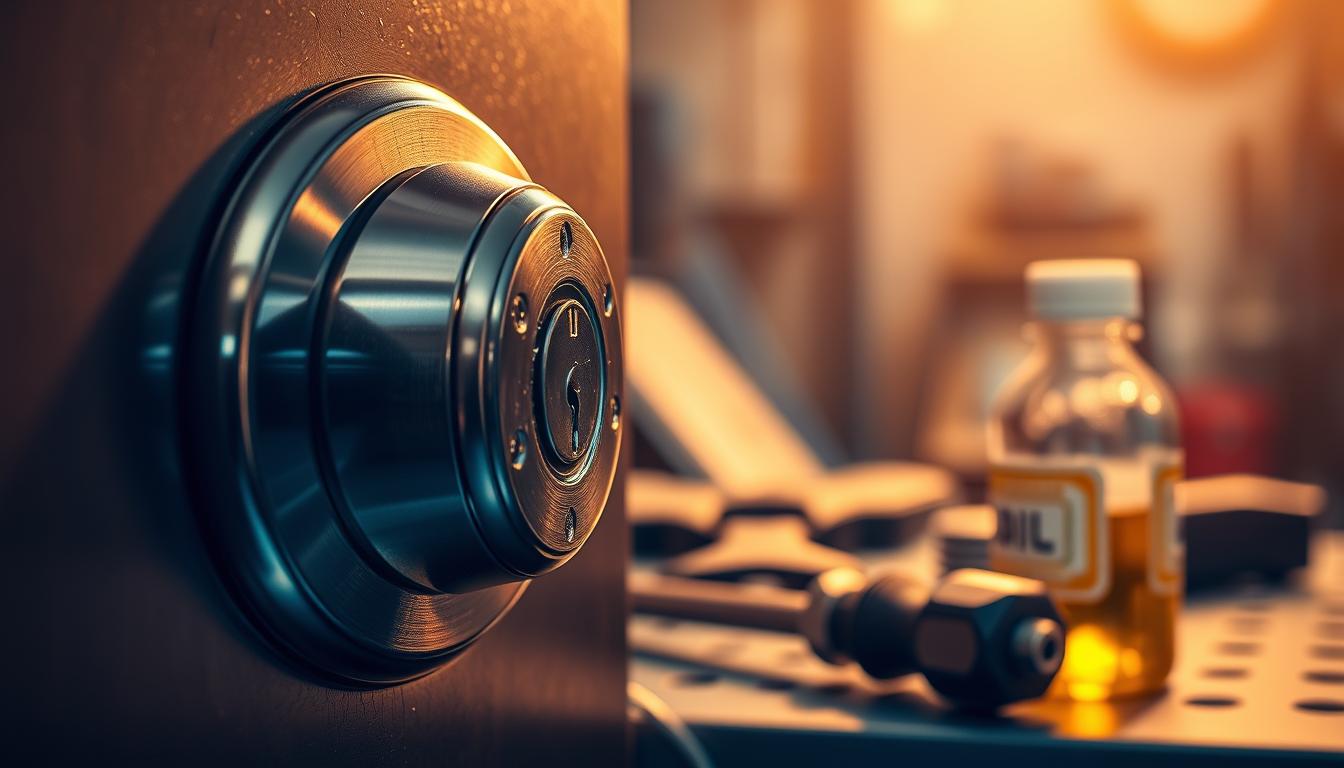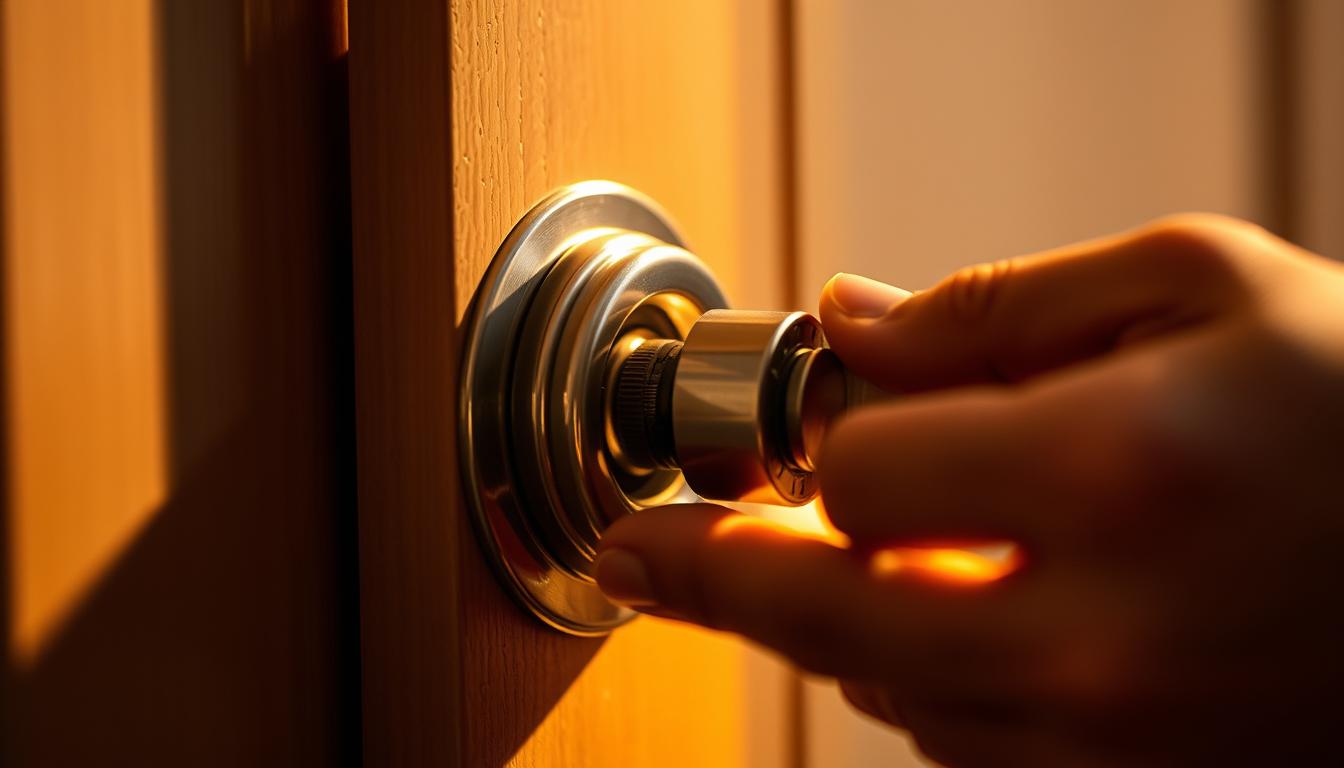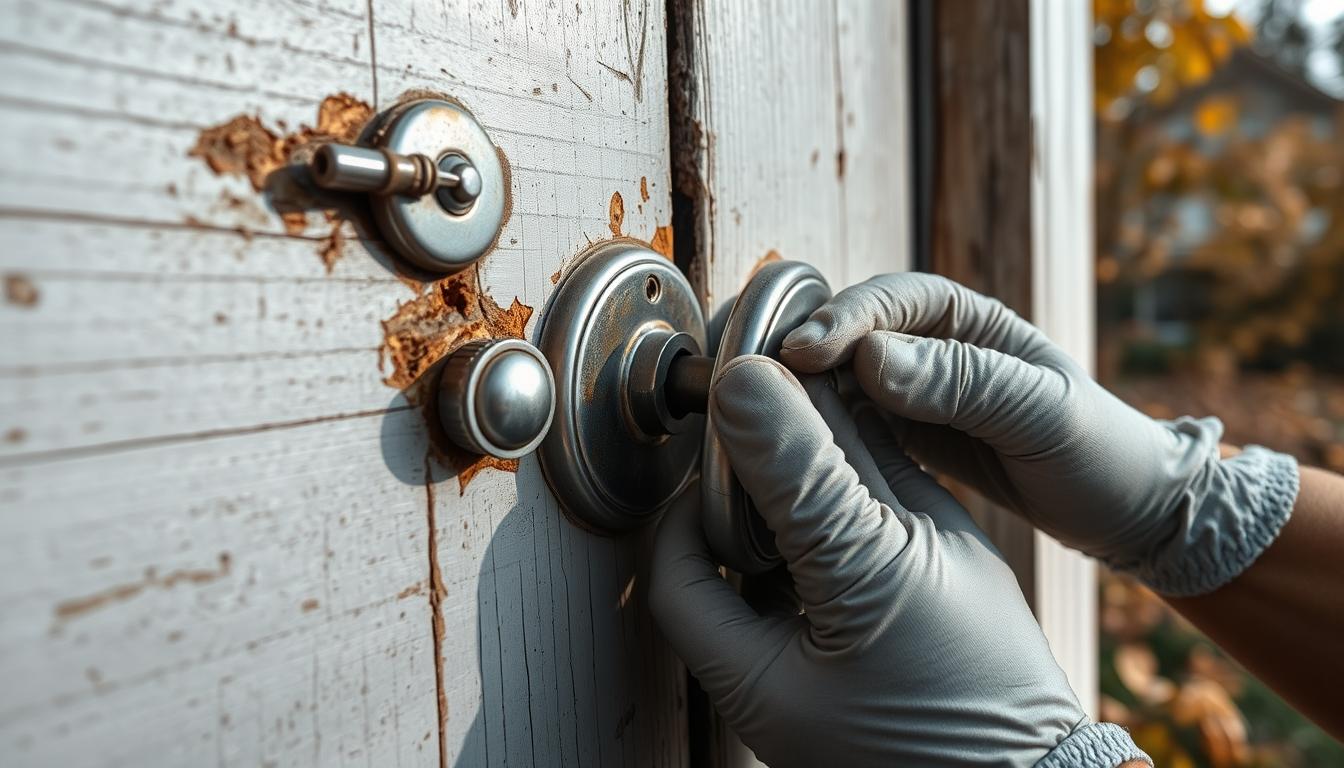As a business owner, ensuring the security of your premises is paramount. One crucial aspect often overlooked is the regular care and inspection of your commercial locks.

Proper lock care not only enhances security but also prolongs the lifespan of your locking systems, saving you from costly repairs or replacements down the line.
Neglecting lock maintenance can lead to malfunctioning locks, compromising the safety of your business, employees, and assets.
Key Takeaways
- Regular inspections can identify potential issues before they become major problems.
- Proper lock care enhances the overall security of your business premises.
- Maintaining your commercial locks can save you money in the long run.
- Neglecting lock maintenance can lead to security breaches.
- Well-maintained locks contribute to a safe working environment.
Importance of Lock Maintenance for Businesses
As a business owner, understanding the importance of lock maintenance can save you from potential security threats. Lock maintenance is a critical aspect of ensuring the security and integrity of your business premises. Regular maintenance of commercial locks not only enhances security but also prolongs the lifespan of the locking mechanisms.
Why Regular Maintenance Matters
Regular lock maintenance is vital for identifying and addressing potential issues before they become major problems. By conducting routine security inspections, you can detect signs of wear and tear on your locks, allowing you to take corrective action. This proactive approach helps prevent lock failures, which can lead to security breaches or costly repairs.
Moreover, well-maintained locks operate more smoothly, reducing the strain on the locking mechanism and minimizing the risk of being locked out or having to deal with jammed locks. Regular maintenance also ensures that your locks comply with security standards and regulations, providing peace of mind for you and your customers.
Consequences of Neglecting Lock Care
Neglecting lock care can have severe consequences for businesses, including increased vulnerability to security threats. When locks are not properly maintained, they can become easier to pick or break, compromising the security of your premises. Furthermore, failing to maintain locks can lead to lockouts, disruptions in business operations, and potentially costly emergency repairs or replacements.
- Increased risk of security breaches
- Higher likelihood of lock failures
- Potential for costly repairs or replacements
- Disruption of business operations due to lockouts
Types of Locks Commonly Used in Businesses
Commercial properties utilize various locking mechanisms to safeguard their premises. The choice of lock depends on several factors, including the level of security required, the type of doors or gates, and the need for access control.
Deadbolts
Deadbolts are a popular choice for commercial properties due to their high level of security. Unlike spring-loaded locks, deadbolts require a key or thumb turn to open, making them more resistant to forced entry. They are typically installed on exterior doors and are available in various grades, with Grade 1 being the most secure.
Smart Locks
Smart locks are becoming increasingly popular in commercial settings due to their advanced features and convenience. These locks can be controlled remotely using a smartphone app, allowing business owners to grant access to employees or contractors without having to be physically present. Smart locks also provide audit trails, showing who entered the premises and when.

Padlocks
Padlocks are versatile and widely used in commercial environments for securing gates, sheds, and storage units. They come in a range of sizes and materials, from lightweight aluminum to heavy-duty steel. Some padlocks also feature advanced security features, such as anti-pick pins and disc tumbler mechanisms.
In conclusion, businesses have a variety of lock options to choose from, each with its own strengths and benefits. By understanding the different types of locks available, business owners can make informed decisions about their security needs.
Tools Needed for Effective Lock Maintenance
Effective lock maintenance requires a specific set of tools to ensure they function properly. Having the right tools on hand can make a significant difference in the longevity and security of your locks.
Basic Tools Needed
For most lock maintenance tasks, you’ll need some basic tools. These include:
- A screwdriver set (both flathead and Phillips)
- A wrench or pliers for gripping small parts
- A can of compressed air for cleaning out dust and debris
- A soft cloth or brush for gently cleaning lock components
- Lubricant, such as silicone spray or graphite powder, to keep lock mechanisms running smoothly
Specialized Lock Tools
Some locks, especially high-security or smart locks, may require specialized tools for maintenance. These can include:
- Key extractors for removing broken keys
- Lock picking sets (for professional locksmiths)
- Specialized lubricants designed for specific lock types
- Battery testers or chargers for smart locks with electronic components
Investing in the right tools for lock maintenance can save time and money in the long run by reducing the need for costly repairs or replacements.
How to Inspect Your Locks Regularly
Inspecting your locks regularly is crucial for identifying potential security risks. Regular inspections help ensure that your locks are functioning properly and can prevent security breaches.

Signs of Wear and Tear
When inspecting your locks, look for signs of wear and tear. These can include rust, corrosion, or worn-out keys. Check if the lock’s mechanism is smooth and if the bolt is aligning properly with the strike plate.
- Rust or corrosion on the lock’s surface
- Worn-out or damaged keys
- Misalignment between the lock and the strike plate
When to Replace Locks
If you notice any of the signs mentioned above, it may be time to replace your locks. Additionally, consider replacing locks if they are old or outdated. Modern locks offer enhanced security features that can better protect your business.
Replacing locks is a proactive measure that can enhance the security of your business. It’s essential to stay ahead of potential security threats by maintaining and upgrading your locks as needed.
Steps to Clean Different Types of Locks
Different types of locks require specific cleaning and maintenance approaches to function optimally. Regular cleaning not only ensures that your locks operate smoothly but also extends their lifespan. Here’s how you can clean and maintain different types of locks used in businesses.
Cleaning Deadbolts
Deadbolts are a common type of lock used in many businesses. To clean a deadbolt, start by dusting off any debris from the lock’s surface using a soft brush. Then, use a damp cloth to wipe down the lock, paying particular attention to the keyway and the bolt. Avoid using harsh chemicals or excessive water, as these can damage the lock’s internal mechanisms.
- Use a graphite-based lubricant to lubricate the lock’s moving parts.
- Insert the key into the lock and turn it several times to distribute the lubricant.
- Wipe off any excess lubricant with a clean cloth.
Maintaining Smart Locks
Smart locks require a slightly different maintenance approach. Begin by checking the manufacturer’s instructions for any specific cleaning recommendations. Generally, you can use a soft, dry cloth to wipe down the lock’s exterior. For the keypad or touchscreen, use a disinfectant wipe, but avoid getting any liquids into the lock’s openings.
- Check the lock’s batteries and replace them as needed.
- Test the lock’s functionality regularly to ensure it’s working correctly.
- Update the lock’s software according to the manufacturer’s guidelines.
Tips for Padlocks
Padlocks are often exposed to harsh outdoor conditions, making regular cleaning crucial. Start by removing any dirt or grime from the lock’s surface using a wire brush. Then, apply a lubricant to the shackle and the lock’s body to keep the internal mechanisms running smoothly.
- Use a silicone-based spray to protect the lock from rust and corrosion.
- Avoid using WD-40 or other penetrating oils, as they can attract dirt.
- Regularly inspect the padlock for signs of wear and tear.
Seasonal Lock Maintenance Tasks
Seasonal changes can significantly impact the performance of your locks, making regular maintenance crucial. As a business owner, understanding how to adjust your lock care routine according to the seasons can help prevent lock failures and ensure the security of your premises.
Fall Preparations
With the arrival of fall, the weather starts to get cooler and more humid. This change can cause locks to rust or corrode if not properly maintained. To prepare your locks for fall:
- Clean your locks thoroughly to remove any dirt or debris that may have accumulated.
- Apply a lubricant to the lock’s moving parts to prevent rust.
- Check for any signs of wear and tear, and replace any damaged parts.

Winter Considerations
Winter brings cold temperatures, which can cause locks to freeze or become stiff. To keep your locks functioning smoothly during the winter months:
- Use a lock lubricant that is suitable for cold weather.
- Avoid using WD-40 or other petroleum-based products, as they can attract dirt and cause locks to freeze.
- Consider using locks with anti-freeze properties or installing heated locks.
Spring Cleaning
Spring is the perfect time to give your locks a thorough cleaning and inspection. As you open up your business after a potentially cold winter, make sure to:
- Remove any dirt or grime that may have built up over the winter.
- Check for any damage caused by freezing temperatures.
- Lubricate your locks to ensure they continue to function smoothly.
By following these seasonal lock maintenance tasks, you can help extend the life of your locks and ensure the security of your business throughout the year.
Professional Lock Maintenance vs. DIY
When it comes to lock maintenance, business owners often find themselves torn between attempting DIY repairs and hiring a professional locksmith. Both approaches have their merits, but understanding when to choose each is crucial for maintaining optimal security.
Benefits of Hiring a Professional
Hiring a professional locksmith offers several benefits, including expertise, efficiency, and warranty on work done. Professionals have the training and experience to handle complex lock issues that may be beyond the capabilities of a DIY enthusiast.
- Expertise in handling various lock types
- Efficiency in diagnosing and fixing lock problems
- Warranty on the work done, providing peace of mind
When to Call a Locksmith
While DIY lock maintenance can be cost-effective for routine tasks, there are situations where calling a professional locksmith is the best course of action. These include when dealing with complex lock mechanisms, handling high-security locks, or when faced with a lock-related emergency.
- Complex lock issues that require specialized tools and knowledge
- High-security locks that demand precise handling
- Lock-related emergencies, such as being locked out of your business premises
In conclusion, while DIY lock maintenance has its place, there are clear benefits to hiring a professional locksmith, especially for complex or high-security locks. By understanding when to call a professional, business owners can ensure their locks are maintained to the highest standard, enhancing overall security.
Upgrading Your Locks for Security
As a business owner, one of the most effective ways to boost security is by upgrading your lock systems. With advancements in technology, locks are no longer just about physical barriers; they now offer enhanced security features and convenience.
Modern Lock Options
Businesses today have a variety of lock options to choose from, depending on their security needs. Some of the modern lock options include:
- Electronic locks that can be controlled and monitored remotely
- Biometric locks that use fingerprints or facial recognition for access
- Smart locks that can be integrated with existing security systems
These modern locks offer not only enhanced security but also the convenience of managing access to your business premises more efficiently.
Benefits of Smart Lock Technology
Smart lock technology has revolutionized the way businesses manage their security. Some of the key benefits include:
- Increased security through advanced encryption and access controls
- Remote monitoring and control, allowing for real-time updates on who is accessing your premises
- Enhanced convenience, as smart locks can be controlled via smartphones or computers
- Audit trails that provide a record of all access events
By upgrading to smart locks, businesses can significantly enhance their security posture while also improving operational efficiency.
Common Lock Problems and Solutions
Common lock problems can be a significant headache for businesses, but knowing how to address them can save time and money. Locks are crucial for the security of any business, and when they malfunction, it can lead to security breaches or lockouts.
Sticking Locks
Sticking locks are a frequent issue, often caused by dirt, grime, or wear and tear. To solve this problem, start by cleaning the lock with a suitable lubricant. If the issue persists, it may be necessary to replace the lock.
Jammed Locks
Jammed locks can occur due to a variety of reasons, including a broken key or internal mechanism failure. For a jammed lock, try to remove the broken key carefully, or apply a lubricant to loosen the jam. If these solutions don’t work, consider seeking locksmith services.
Broken Key Issues
Broken keys are another common problem. If a key breaks inside a lock, use needle-nose pliers to carefully remove the broken piece. For more complex situations, a professional locksmith can provide the necessary assistance.
Understanding these lock solutions can help business owners address common lock problems effectively. Regular maintenance is key to preventing many of these issues.
In some cases, despite your best efforts, you may need to call in a professional. Knowing when to seek locksmith services can save you from further complications and ensure your business remains secure.
- Regularly inspect and maintain your locks to prevent common problems.
- Keep a record of maintenance activities to track the health of your locks.
- Consider upgrading to smart locks for enhanced security features.
Creating a Lock Maintenance Schedule
Establishing a regular lock maintenance schedule is crucial for ensuring the longevity and security of your business’s locks. Regular security inspections help identify potential issues before they become major problems.
Inspection Frequency
It’s recommended to inspect your locks at least twice a year. However, the frequency may vary depending on the type of locks used and the environmental conditions they are exposed to.
Maintaining Records
Keeping detailed maintenance records is essential for tracking the history of your locks’ maintenance. This includes noting the date of inspections, any repairs made, and parts replaced. Accurate maintenance records can help extend the life of your locks and ensure compliance with security regulations.
By implementing a lock maintenance schedule and maintaining thorough records, businesses can ensure their locks remain in optimal condition, providing maximum security and minimizing potential downtime due to lock failures.

